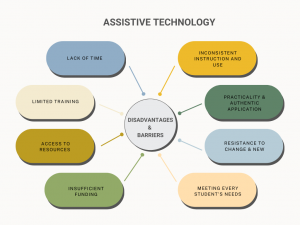Assistive Technology – Week 10
First off, I would like to say what a fantastic job this week’s presenters did! Jokes aside, thank you to my group mates Colton and Todd for their hard work. That was officially my last master’s presentation ever and I feel very thankful for my awesome groupmates.
For the first 7 months of my teaching career I spent a lot of time subbing in elementary schools. It was during that time I realized how complex student’s needs can be. Throughout my internship I remember having two students with ROA’s that required them to have additional time to complete assignments. My experience with assistive technology was limited until I began subbing and accepted a contract at my current high school. One day when I was subbing in an elementary school I was instructed (from the sub notes) to take away a student’s laptop if they were not using it productively. When I attempted to take the device away the student refused and I told them I was going to call home and as I made my way to the phone the student picked up the laptop and threw it across the room at me. FUN. Now I work at a school where I have 15+ students with ROA’s and IIP’s and assistive technology is much more prevalent.
As I mentioned in the presentation there are several challenges and limitations to using assistive technology in the classroom.
- Lack of time – specifically for teachers to research, source, purchase, teach themselves how to use it and then authentically incorporate it into the lesson.
- Limited training – unless you have taken inclusive education classes or partake in inclusive PD sessions, a lot of assistive technology is going to seem intimidating.
- Access to resources – we know we want to help our students succeed, but how? Where do we even start? Who can we contact?
- Insufficient funding – Budgets are always tight, and difficult to navigate.
- Inconsistent instruction and use – as students move from grade to grade assistive technology can become a crutch or an escape. Having different teachers’ expectations can be very overwhelming for students.
- Practicality and authentic application – The “we bought this, so we better use it” and it is thrown into lessons unauthentically.
- Resistance to change and new – everyone is weary of change, both teachers and students can feel those effects when something new is introduced.
- Meeting every student’s needs – how can we possibly meet everyone’s needs? With all the other points I just discussed, who is priority, who receives what they need and who might not. Those are challenging decisions for teachers to make.

I would say the challenges I struggle the most with are limited training, inconsistent use and authentic application. I do not feel like I have been given the time or resources to fully understand the potential of the assistive technology my students use or what is available to me. I also find that teachers having different expectations for laptop use is detrimental to the students engagement and success in the classroom. I need to be better at incorporating my students assistive technology authentically in both the classroom and the gym.
Botelho’s work also highlights several challenges to using assistive technology in the classroom. Some of the barriers Botelho included are, lack of awareness, lack of governance including legislation, policies, and national programs, lack of services, lack of products, inaccessible environments, and financial barriers. The article was also easy to connect to the discussions we had after the presentation in terms of accessibility and government programs. It was interesting, but also discouraging to hear how advanced Manitoba is in comparison to Saskatchewan. Gilles shared the article Government introduces Accessible Saskatchewan Act in effort to remove disability barriers in the Discord chat the day after the presentation. If the new legislation is passed The Accessible Saskatchewan Act will formulate a committee where half of the members will be persons with disabilities to develop and improve accessibility standards in Saskatchewan. This new legislation is going to impact everyone in Saskatchewan. I am looking forward to seeing the positive changes in our schools and the community.
If you are interested, you can read the summary of the bill here.
Lastly, I want to address Jane Velkovski’s Ted Talk, “The Life-Changing Power of Assistive Technologies”. This was one of the first video’s I watched when I began researching for the presentation. I was blown away by his speaking and his message. I also really appreciate YouTube’s closed captions and transcript they provide. In the talk, Jane states “I am forever grateful to the family that donated my power chair, but my freedom, independence and ability should not depend on luck or charity. No one’s should be. This assistive product needs to be available to everyone who needs it”. This line really stuck with me because it is so true. As an able-bodied person, I never have to think about if I can go places, perform tasks, etc. Jane’s talk reinforces the importance and necessity of The Accessible Saskatchewan Act. I can only hope our government sees the importance of this bill and what it would mean to Saskatchewan residents and visitors.
Thank you to everyone who participated in our presentation.